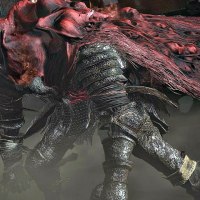Some time ago, InReview released a piece where we explored some of the lesser-known weapons across the franchise that are and aren’t worth using. Like before, today we will have a look at some less than popular picks that either make sense or don’t.
Demon’s Souls

Wield: Morning Star
This is definitely not the most exciting choice for this slot. Unfortunately, Demon’s Souls’ weapon catalogue is distinctly bland compared to the rest of the franchise and is much smaller than all but Bloodborne. As a result, strong weapons are well known just as the weak ones. Having said that, if you’re a simple player, you want a good, effective weapon and don’t care to get into any stats or conditions which are too complicated, the Morning Star is the pick for you. Not only is it’s damage output up to par for a mid game weapon to go with modest stat prerequisites, but it also inflicts Bleed and is a Strike melee weapon. The Bleed isn’t a whole lot, but it can really make a difference against tankier enemies such as Vanguard Demon, Leechmonger (if not fighting with fire) and Old Hero. Being a Strike weapon is actually important because the game’s other Strike weapons are either mostly horrible, or are the Brandt and have massive stat requirements only dedicated builds can meet. Even though the Morning Star isn’t flashy by any means, it gets the nod for the ‘wield’ category here.

Do Not Wield: Baby’s Nail
I see you eyeing that Plague build up on this weapon. Plague is basically Demon’s Souls’ version of Toxic or Scarlet Rot, rapidly draining the enemy of their health and lasting quite awhile. Before you think this makes the Baby’s Nail good, as the only Plague inducing weapon in the game, you should go ahead and try it. You’ll quickly found out how awful it is having a weapon which is so tiny that it can barely hit anything. That’s not even an exaggeration, as the effective range on this weapon is so bad that the player can miss attacks against adjacent enemies because of the angle they were facing them. In order to actually inflict anything with Plague, you’ll need to hit them about a couple dozen times in rapid succession. If there is too long of a break between hits, any build up you had will decay. Against bosses, this will either prove impossible or much needlessly harder than a more standardized playstyle. Only use this weapon in challenge runs.
Dark Souls 1

Wield: Moonlight Butterfly Horn
The Moonlight Butterfly can be an annoying boss to fight, and because it’s entirely optional, most players won’t bother. If you’re running a sorcery build though, it’s totally worth it, because this weapon is amazing. It’s just one of two weapons in the game to deal strictly Magic damage, and though it is generally viewed as slightly inferior to the Moonlight Greatsword, it has some unique traits to distinguish itself and is overall a fantastic weapon. Being a spear with solely Magic damage means the horn can totally dominate enemy greatshield users, whose shields won’t be equipped to deal with such heavy magic damage. They will also find themselves outranged by the horn, ultimately forced to drop their shield, become vulnerable and engage you more directly. Deploy and enjoy.

Do Not Wield: Smough’s Hammer
This one feels a little unfair, because technological limitations and perhaps a developer oversight are somewhat of the cause for this weapon appearing here. The hammer deals excellent damage and even slightly heals the user upon use. One major problem, however, is that the hammer itself is so massive that it visually blocks the player from seeing a large chunk of their own character, which can create problems trying to dodge attacks or contend with an enemy in close quarters. Additionally, though the hammer deals good damage, it isn’t special for claiming to do this. Other colossal weapons such as the Dragon Tooth or Dragonking Greataxe hit perfectly hard enough themselves. The other issue is in the hammer’s absurdly massive Strength prerequisite, requiring an obscene 58 Strength to use. Unless you specifically plan to use this weapon, you more than likely won’t hit this number in a typical, normal playthrough. It can indeed be wielded with two hands as low as 39 Strength, but again, other weapons can make this claim with a lower requirement and very similar numbers. For all the baggage it brings, you can skip out on the Smough’s Hammer in Dark Souls 1.
Dark Souls 2

Wield: Scythe of Want
In the earlier days of Soulsbornes, scythes had it rough. They only dealt particularly good damage if the tip of the weapon hit. This makes real-life sense, as nobody fears the flat base of the weapon, but it means a fast paced game will create problems with this being the case. The Scythe of Want’s unique moveset provides a way around this, with its two-handed right-handed heavy attack (frequently known as ‘R2’) will involve the character pulling in the scythe and swinging the blade point blank, which would catch enemies in close quarters that other scythes would totally miss. Additionally, the scythe deals split damage and scales with Intelligence and Faith, a massive boon for Hex builds, arguably the strongest playstyle in the game. With the scythe dealing split Dark damage, it fits these builds like a snug mitten. Conveniently, many important and challenging bosses in the game, such as Blue Smelter Demon or Sinh the Slumbering Dragon are best approached with Dark weapons. Overall, it isn’t conventional and could prove tricky to effectively wield, but the Scythe of Want is worth the challenge it imposes in order to use.

Do Not Wield: Miracles in general
Though technically not an individual weapon, people who have not played Dark Souls 2 may be surprised to learn that almost every Miracle in this game flat out sucks. Healing Miracles are rendered totally redundant and massively outclassed by Life Gems and even lowly Estus Flasks, as Life Gems do not have any stat requirements, can be used much more quickly than Miracles, they can be purchased infinitely, the player can hold up to 99 at a time, and they don’t take up any inventory slot that would be better served with something else, similarly to how Miracles take up spell slots. Miracles intended to deal damage such as Lightning Spear are generally pitifully weak or, at best, situationally useful. Soul Appease can annihilate the Royal Rat Vanguard, the Rotten or some group of hollows, while Heavenly Lightning at least deals respectable damage against Lightning-weak enemies. That’s about it. If you intend to invest into Faith, do yourself a favor in also investing in Intelligence to make a Hex build. You could also wield Pyromancies using the Faith stat. Steer clear of Miracles.
Bloodborne

Wield: Kirkhammer
Similarly to Demon’s Souls, the Kirkhammer is probably the least exciting weapon in the game and is found early on or acquired very cheap. However, it’s basically a massive hammer that can also turn into a simple short sword, so while it isn’t super flashy, it gets the job done even at end game if so desired. It’s a very simple idea- if you want speed to deal with a fast paced situation, use the sword. If you need some more lethality and can afford being a notch slower, bust out the hammer.

Do Not Wield: A Call Beyond
Micolash and Ebrietas make A Call Beyond look like the most overpowered thing in all of Soulsborne. Once you get your hands on it, should you have the stats to use it, you’ll probably envision similar results to the many times they probably one-shot you with it. Unfortunately, as with most things in Soulsborne, the version that the player gets is vastly inferior to the one that the enemy receives. It costs more than half the Quicksilver Bullets the player is able to carry at base, and is extremely hard to actually hit with. If you do hit with it, it will indeed deal devastating damage. The problem is that the spell shoots several rays of light in all sorts of different directions, and the player has zero control over where they’re aimed. Naturally, the spell will always be inconsistent. For the absurd cost to the player’s bullet supply and massive Arcane stat needed, A Call Beyond would be better suited buried in your inventory.
Dark Souls 3

Wield: Greatsword of Judgment
Between both of Pontiff Sulyvahn’s weapons, the Profaned Greatsword tends to get more hype due to its size and slightly higher all around stat build. However, the Greatsword of Judgment is a major sleeper pick especially for Intelligence builds. It’s unique weapon art allows the player to fire off a massive purple beam of magical energy similar to when it is wielded by Sulyvahn. Additionally, the weapon itself is classed as a greatsword, yet deals damage on par with an Ultra Greatsword, with weight and speed of use reeled back to greatsword levels. Overall, the sword’s performance is very similar to the Moonlight Greatsword. Deploy and enjoy.

Do Not Wield: Smough’s Great Hammer
Once again, we find ourselves being pretty mean to this one. Like before, the weapon isn’t even that bad, dealing usable damage for its class and returning its unique per-hit self heal. As well, issues using the weapon and still seeing the player’s character have been rectified. Big issues here involve the weapon’s statbuild, in addition to being even more heavily outclassed in this game than Dark Souls 1. For the former, it’s enormous Strength requirement from Dark Souls 1 has been lowered to a much more reasonable 45. As well, the scaling on this weapon actually received a massive buff, going from just a lowly D in Strength in Dark Souls 1 to a still mediocre but much improved B when fully upgraded here. Still yet, there are many, many better and even more efficient options. The Ledo’s Great Hammer is the most popular example, but the majority of this game’s colossal weapons or Ultra Greatswords can make this claim. Unfortunately, for just a B in Strength, the Smough’s Great Hammer imposes a 24 pound cost to the player’s equip load. This is much less efficient than Ledo’s for example, which may be heavier at 28 pounds, but has a much better scaling in Strength and simply does much more damage, making the extra four pounds more than worth it. This type of problem follows the Smough’s Great Hammer when comparing it to just about any other colossal weapon. Steer clear of it.
Elden Ring

Wield: Grafted Dragon
This is admittedly an ambitious pick that does require a relatively well-refined palate for trying new strategies in order to truly appreciate. The Grafted Dragon is a fist weapon, an archetype which has unfortunately only seen very limited success over the years. It is similarly niche, but has more going for it than just an average Caestus. It’s Ash of War is predictably the big ticket here, known as “Bear Witness!” Bear Witness! is like trying to use Captain Falcon’s Falcon Punch in Smash Bros, only when you’re using it, you gain an extreme amount of poise, making the attack difficult to interrupt, impossible even for certain builds. The punch is delivered in upper cut fashion, pointing the dragon upward and then allowing it to follow up and spew a short amount of area in front of you with flames. Overall, as far as fist weapons go, this one is pretty great. It offers reliability, slight protection from punishment at a distance, and its stat requirements are pretty modest. It may not be strong enough to be used alone and defeat a boss such as Malenia by itself, but it is an excellent choice for a sidearm or backup weapon to be used situationally. Deploy and enjoy.

Do Not Wield: Grafted Greatsword/Golden Order Greatsword
Both of these weapons are extremely disappointing, and given that they’re both labeled by the game as ‘legendary armaments’ and are directly tied to 100%ing the game, it felt appropriate to include them both.
The Grafted Greatsword has had some bizarre concept design behind it. Not just visually, but with how it gets used in combat. It’s 40 Strength requirement and status as a legendary weapon suggest that it’s meant for the late or end game. However, it’s exclusive Ash of War in Oath of Vengeance gives the player a +5 to all of their stats briefly when used. This is an Ash of War which is incredible in the early game, but drops off to near uselessness end game. See the awkward synergy here? Because of this, the Grafted Greatsword plays like an inferior version of a basic Greatsword.
The Golden Order Greatsword, on the other hand, is somehow worse than the Grafted Greatsword. Dealing split Holy damage is annoying enough, but other weapons deal split Holy and manage to be excellent choices, such as the Black Knife or Maliketh’s Black Blade. What the Golden Order Greatsword is missing that they have is a good Ash of War. The Golden Order Greatsword’s exclusive Ash of War is “Establish Order”, which is pretty much just a way slower and weaker version of Dark Souls’ Wrath of the Gods miracle. As a result, this weapon is utterly horrible and isn’t worth using apart from meme or challenge builds.





Leave a comment